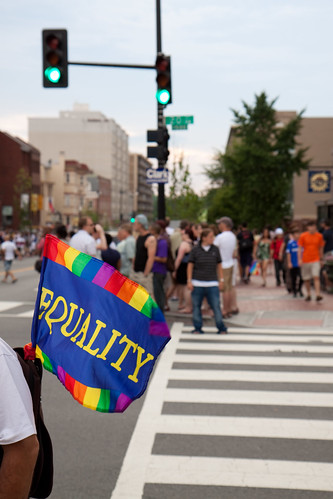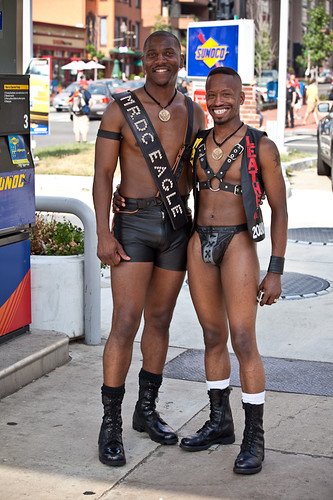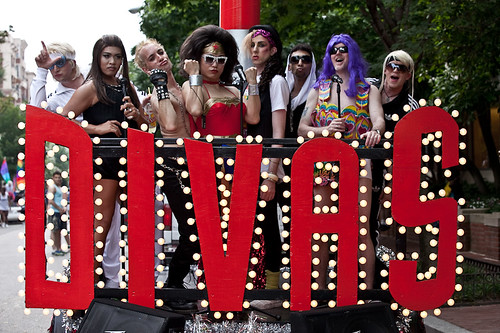
‘Equality’
courtesy of ‘ep_jhu’
When DC’s first Pride event took place in 1975, there was no AIDS. There was no same-sex marriage. Rocks were thrown at windows of gay businesses. There were no laws protecting LGBT individuals in the workplace. My, how much has changed. As rights have been won and acceptance has grown, the District’s LGBT community has flourished and thrived, as this year’s blockbuster Pride celebration reflected. As the photos here document Capital Pride 2010, which ended yesterday, here’s a look back on 35 years of celebration, change and progress.
More than 250,000 people were expected at this year’s festivities, which ran over a week long and included parties, concerts, cultural events, and of course, the famous Pride Parade. DC’s first Pride festival was a little more humble. There was no central planning committee, just Deacon Maccubbin, the founder and longtime owner of Lambda Rising, Dupont’s iconic LGBT bookstore that closed its doors earlier this year. Instead of heading up to New York for Pride, Maccubbin and a few friends wondered why they didn’t just organize an event in Washington instead. The idea took flight, and the first Gay Pride Day was held on the third Sunday in June outside Lambda Rising’s original location at 1724 20th Street NW. There was a beer truck, a soft drink truck, and dozens of booths set up by community organizations. Two thousand people came by, which Maccubbin says was an unprecedented number for the city’s LGBT community. “It was like throwing a party for a whole bunch of people I didn’t know were my friends yet,” Maccubbin recalls.

‘Capital Pride Parade 2010’
courtesy of ‘spiggycat’
From the start, Pride was designed to showcase the diversity of the LGBT community. Maccubbin remembers a racially mixed crowd of both genders, and a special effort was made to include as many different groups as possible in the planning process. Boden Sandstrom was the owner of the all-female sound company Woman Sound, which was hired for the event. “It was very gratifying to be supported as lesbians in the gay community,” Sandstrom says. “We were thrilled to be there.”
Although Maccubbin was aware that DC’s first Gay Pride Day was politically and socially significant, he didn’t envision the full extent of what he had set in motion. “I don’t know if you ever know that you’re making history when you’re doing [something]…[organizing Pride] seemed to be the right thing to do at the right time. So we just went ahead and did it.”

‘Prideful’
courtesy of ‘DC9T’
With the perspective of 35 years however, it’s much easier to appreciate what Mr. Maccubbin began. Capital Pride has grown exponentially through the years, and is today one of the country’s largest gay festivals. Ms. Sandstrom, who worked on many subsequent Prides and LGBT events said her sound equipment “kept getting bigger and bigger because the community kept getting bigger and bigger.” Instead of booths manned by neighborhood associations, major corporations and banks now help sponsor the event. While some miss the more intimate community feel of Prides gone by, it’s clear that having nationally known supporters show just how far things have come. Whatever hesitation may have once existed about affiliation with an LGBT cause is slipping away.

‘Capital Pride Parade 2010’
courtesy of ‘spiggycat’
Of course, it’s not just corporate hesitation that has changed – it’s individual hesitation too. At the first Gay Pride Day, members of the press had to be monitored to ensure the privacy of individuals who didn’t want to be photographed. Being outdoors at a public gay event was understandably a source of concern for many attendants. “It was very courageous in the 70s and 80s to hold this celebration,” says Bernie Delia, Vice President of Capital Pride Alliance, the festival’s current organizing arm. “There were still people in DC who were not out and feared losing their jobs.” These days, discretion is not exactly a major priority at Capital Pride, as anyone who witnessed Saturday’s sequins, leather, feathers and skin can attest to.
It was brave too to continue Pride during the height of the AIDS epidemic. Delia, who became involved with Pride in the mid-1980s, described how difficult it was to lose people “who were working with us side by side. We felt those losses very, very strongly.” At the same time, he said “we always recognized that it was very appropriate to take some time out to stop and celebrate. It’s important to the human condition to do that.” Sandstrom too remembers that despite the tragedy of those painful years, “women and men became closer and closer” as lesbians rallied around the city’s disproportionately affected gay men. Pride became not just a source of celebration and activism, but a source of remembrance too.

‘Capital Pride Parade 2010’
courtesy of ‘spiggycat’
This year however, it was the LGBT community’s recent victories that took center stage. From the passage of the Matthew Shepherd Hate Crimes Prevention Act to the District’s legalization of same-sex marriage, the past 12 months have seen undeniable triumph. “Did I think four decades ago we’d ever get to the point we’ve gotten to today?” Maccubbin mused. “Yes, I did believe we’d get to this point. The only difference was I didn’t believe it would happen in my lifetime. It’s a wonderful thing.”
Yes it is. Here’s a special thank you to all the individuals who made this year’s Capital Pride a success, and who helped give Mr. Maccubbin such wonderful things to celebrate in his lifetime.
Pingback: Photo Friday: “It seemed the right thing to do, so we just went ahead and did it” | Ted Eytan, MD